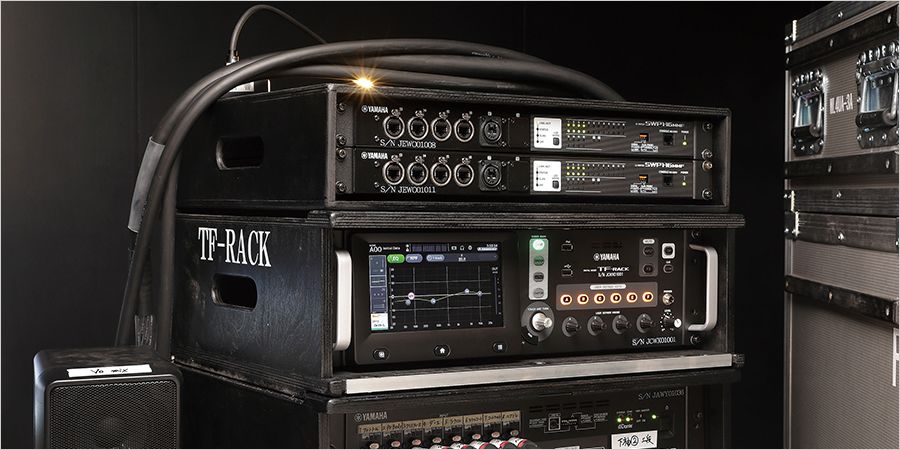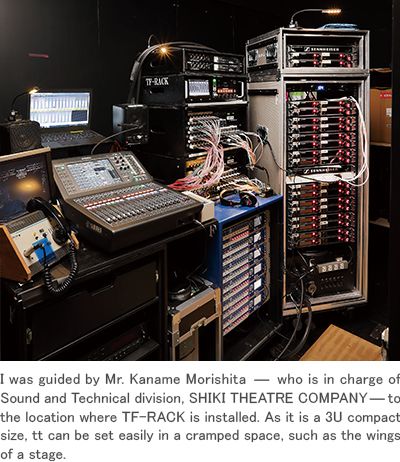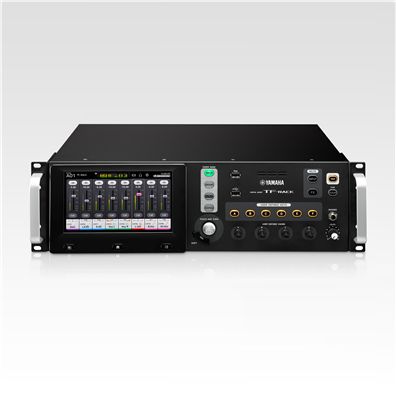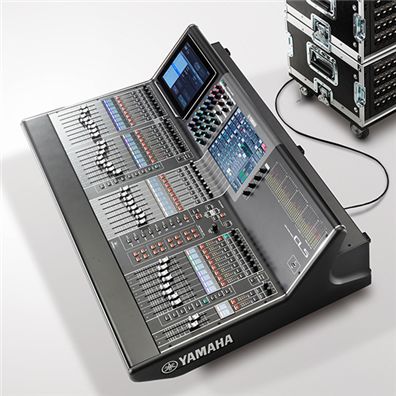Yamaha TF Series, a Digital Mixer Gaining Trust in Various Scenes - SHIKI THEATRE COMPANY

Yamaha’s TF series, digital mixer for PA, have characteristics of compact bodies and intuitive operability with their touch panels. In this episode, we will focus on some examples on introducing rack mount type. TF-RACK is a new model that was released at the end of 2017, which realized further miniaturization from the traditional surface type model. The 3U casing is a compactly equipped with 16 microphones and 16 line in-and line outs, having a maximum mixing capacity of 40 line ins. Moreover, it can be connected with the audio network, Dante by adding an expansion board NY64-D. Since We have heard that it is being used in SHIKI THEATRE COMPANY’s “The Phantom of the Opera”, I have visited the venue KAAT (Kanagawa Arts Theatre) for an interview.
Reasonable Price while Being Equipped with Sufficient Specifications
SHIKI THEATRE COMPANY’s “The Phantom of the Opera” is being performed at KAAT (Kanagawa Arts Theatre) for approximately 6 months from March 25 (Sat) to August 13 (Sun). TF-RACK is being used as an “operation system” at this venue, sending sounds on the stage of the current production to posts of recording and stage machinery, light control rooms below-stage basements, backstage and more. “The reason for this is for the person in charge of each section to seize the progress of the performance on a real time basis”, says Mr. Masakazu Kanamori, who is in charge of Sound and Technical division at SHIKI THEATRE COMPANY.
“We have used an analog mixer until the end of last year, however, if it was placed at the wings of a stage, it tended to occupy space. Therefore, I thought to replace it with a compact digital mixer, and was giving consideration to introduce TF series (surface type model), then at a good time, rack mount-typed TF-RACK was announced. Compared to the surface type model, this is a more small-footprint model, and I thought that it was attractive as it is equipped with 16 output terminals on such a compact model, which is quite rare. Various monitor mixes are required to be created to meet the needs of requests from each section, regarding operation systems. Thus, the number of outputs is an important element in selecting mixers. Although there are some custom-made mixers that can construct matrix, those mixers are very expensive, so having a reasonable price was also a motive for introduction.”
Highlighting Points I Compact 3U Body

He seems to be fascinated with it being compatible with Dante, in addition to other features, such as the compact size, plenty of output terminals and reasonable price. We had a look at the scene’s TF-RACK upon the interview, but nothing was plugged in on the input terminals. “That’s because we patch signals via Dante”, says Mr. Kanamori.
“We adopt Yamaha’s CL5 console as a core for PA system and we input stage box’s direct out on TF-RACK. We can patch on a software called Dante Controller for PC, if we connect each device to the Dante network, so it does not take time as connecting stage box and TF-RACK with cables. Our future vision is to prepare multiple TF-RACK units, patch them to CL series with Dante and to use them as a sub-mixer for FOH. As an example, musicals requires up to 200ch, as it includes orchestra. If we prepare a console for receiving them, the seating space for PA will be big and will occupy some audience seats. That’s when TF-RACK is most needed. It is capable of mixing many lines even without taking a lot of space, if you prepare several units and use them as a sub-mixer, and moreover, the main console will be small. We may be able to cover a stage by just preparing 2 units of CL1, which is the minimum unit of CL series. In addition, the seating space for PA will be small in due course, so we can accommodate more customers.”
Highlighting Points II Compatible with Dante

This is TF-RACK’s back panel. Although the output terminals in the left of the picture are connected with cables, the input terminals in the right side are not used. Moreover, it can be connected with the audio network Dante by adding NY64-D. This is because the outputs of the main console are patched with Dante by an expansion board, NY64-D, added below the input terminals.
Internal Processor is also the Secret of Small-footprint
Each internal signal processor contributes to small-footprint.
“When we were using an analog mixer, we had to prepare an outboard if we wanted to create a sound effect, so it also caused the system to be large. However, TF-RACK is embedded with processors that we use frequently, including compressor and time alignment delay, which is helpful since we can cut down the number of external devices. This is convenient for some local theaters, as they have thoughts of “installing a mixer at the wings of a stage as a permanent device besides a main mixer”. Moreover, its operating method is very simple with it being easily utilized by non-professional engineers, so I think that it is useful as a facility for hotels and stations as well.”
SHIKI THEATRE COMPANY seem to utilize TF-RACK in their future performances as well. They will continue being a promising partner, as Mr. Kanamori says “it is already programmed into the schedule until next March”.
From the August 2017 edition of the monthly Sound & Recording Magazine. Photograh by Takashi Yashima.
Related Products
Location
Japan



